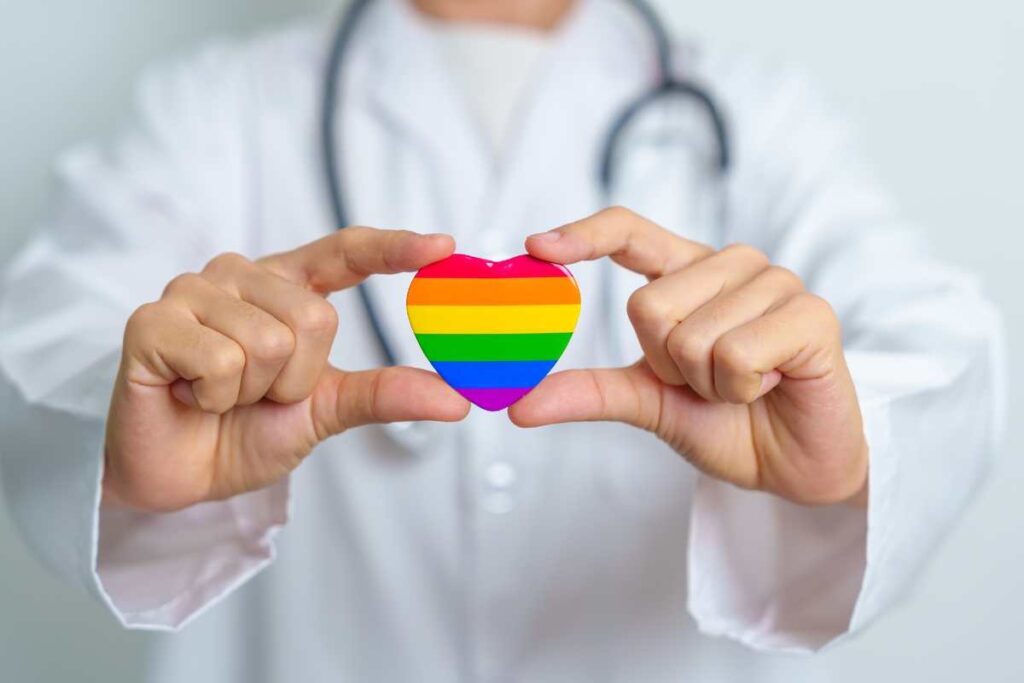Menopause happens to people, not just those who identify as women.
Tania Glyde, psychotherapist
LGBTQIA+ and menopause
The menopause journey is a natural biological process that marks the end of a person’s menstrual cycles, typically occurring in their late 40s or early 50s.
Many menopause experiences and symptoms are common across sexual orientations and gender identities. However, there can be potential differences for different individuals.
For LGBTQIA+ individuals, there may be unique concerns, advantages, and considerations during menopause.
Make menopause a time in your life for
renewal,
freedom,
and a greater focus on your needs.
LGBTQIA+ menopause pride and positivity
Your mindset can change your menopause journey and improve symptoms.
In general, LGTQIA+ people tend to have:
A more optimistic outlook on the menopause journey and aging.
If this sounds like you, then you’re on the right track and much further along than many people who often dread it. A positive outlook can actually reduce the severity of some menopausal symptoms.
If that’s not you, it’s never too late to make a change for the better or seek help from a mental health professional.
Community strengths
A qualitative study of people of color who were members of the LGBTQIA+ community found study participants reported community strengths, which included:
1. interconnectedness and resource sharing
2. safety, acceptance, support, and safety within the community
3. community potential through advocacy and collective action.
But every menopause journey is unique, and challenges are to be expected.
Potential challenges
LGBTQIA+ people may experience challenges with these menopause symptoms;
Changes in mood and emotional well-being.
Irritability, anger, depression, and anxiety occur because of hormonal changes, as well as other challenges common during the menopause journey.
In fact, depressive symptoms affect 45-68% of women during this period.
If your mental health is already a concern before menopause, your emotions can be exacerbated by the menopause journey. In fact, mental health disparities are evident for LGBTQIA+ people during the journey which are detailed below.
Life changes
For those experiencing the onset of menopause during midlife, the journey can bring a host of additional changes in your life, such as work (e.g., promotion, retirement), empty nest syndrome, or the caregiver “sandwich” — aka tending to the needs of both kids and elderly parents — which add to the complexity of navigating the hormonal transition.
These life changes may happen at the same time or before/after other life changes like medical and/or surgical transitioning.
Vaginal dryness and lower sex drive.
While women in lesbian relationships are less likely than their heterosexual counterparts to experience changes in sexual functioning and desire for sexual activity, including pain during penetrative activity, e.g., use of a vibrator or sex toys, these symptoms can still be present.
Body image struggles
As their bodies change, LGBTQIA+ individuals often have a more positive body image than heterosexual women.
For many, both the end of “femininity” as defined by societal standards and the impact of aging on traditionally held views of beauty may have a less negative psychological effect compared to people who may be more emotionally invested in staying forever young.
That said, menopausal symptoms such as hair changes/loss, weight gain, and changes in the scent of your body may be upsetting.
These menopause symptoms can be experienced by women+, including trans men.

Menopause health disparities
The menopause journey increases a woman’s risk for several conditions, including cardiovascular disease, weight gain, and mental health concerns.
As an LGBTQIA+ person, this risk can go up, and sometimes that happens disproportionately, which makes it a health disparity.
Let’s talk about these disparities for an LGBTQIA+ person.
1. Increased cardiovascular disease (CVD) risk
If a person is assigned female at birth and maintains that status, the typical estrogen level profile is protective up to the onset of menopause with regard to conditions like heart disease, osteoporosis, and potentially dementia (studies are mixed, and there is controversy in the medical community).
As estrogen levels plummet and eventually level out at a much lower baseline during the post-menopause, the risk of cardiovascular disease (hypertension, heart disease, and stroke) increases, along with the risk of elevated LDL (“bad” cholesterol) and triglycerides and decreased HDL (“good” cholesterol).
And some LGBTQIA+ individuals may enter menopause with higher baseline levels of risks for CVD. For example, in transgender women, hormone therapy may be a risk factor as well. As one study found, transgender women taking estrogen had higher rates of stroke (and blood clots) than their cisgender counterparts.
Researchers have also linked increased risks of CVD to chronically elevated cortisol levels (the “stress hormone”) triggered by discrimination. Some research indicates exposure to anti-LGBTQIA+ discrimination can increase mental and physical health risks for a variety of conditions. Additionally, the community is disproportionately exposed to psychological and social stressors throughout their lives.
Another cause for a greater likelihood of CVD may be certain lifestyle-related risks. Data from the Women’s Health Initiative shows that lesbian women, for example, demonstrated a higher incidence of risk factors like smoking, obesity, and alcohol consumption, with smoking and obesity being the most common risk factors for heart disease in this group.
LGBTQIA+ people are also less likely to access healthcare services that could be preventive, with reported causes being past negative experiences when seeking care, as well as difficulty in finding welcoming, culturally-sensitive healthcare practitioners with the training and experience to address what can be unique needs of some individuals in the community.
2. Weight gain
While weight gain is a common symptom for heterosexual women during the menopause journey, lesbian and bisexual women are more likely to enter the menopause journey being overweight or obese, and the trend continues as they get older.
3. Mental health
The hormonal changes that occur in many people during the menopause journey can increase the risk of mental health conditions like depression and anxiety as well as emotional distress related to stress. If these conditions are preexisting, a new episode may be triggered, or a current episode may exacerbate.
As noted below, some LGTQIA+ individuals on the menopausal journey may already have a higher baseline rate of the conditions for which menopause increases the risk.
The LGBTQIA+ community has a higher prevalence of mental health conditions compared to the general population:
- LGB adults are more than twice as likely as heterosexuals to experience a mental health condition.
- Transgender people are almost four times as likely to do so.
- More than 25% of bisexual females and approximately 15% of lesbians reported having had a major depressive episode (MDE) between 2021 and 2022, according to the Substance Abuse and Mental Health Services Administration (SAMHSA). And bisexual females were six times more likely to have attempted suicide within the same timeframe than cis heterosexual women.
- The rate of anxiety is also higher, with the 2022 CDC Household Pulse Survey showing 32% of LGBTQIA+ adults aged 45-65 have anxiety compared with 26.2% of non-LGBTQIA+.
According to the National Alliance on Mental Illness, contributory factors to this greater prevalence include:
- Exposure to bias, discrimination, and anti-LGBTQIA+ hate
- Trauma
- Rejection at home, work, and/or religious settings
- Inequities in socioeconomic status (SES: a measure of an individual’s or group’s standing in the community and refers to an individual’s position in a society, which is determined by income/wealth, level of education, occupation, and social class)
Additional factors can include:
- Stigma
- Adverse events during childhood
- Social exclusion
- Identity concealment
Call 9-8-8
Disparities in care for LGBTQIA+ patients
In addition to health disparities, there are also differences in care.
In general, LGBTQIA+ individuals may avoid seeking care due to:
- prior negative experiences
- discrimination
- fear of these experiences
- fear of medical gaslighting
For example, in a recent study from the American Association for Cancer Research, 16% of people who identified as sexual or gender minorities reported discrimination while seeking healthcare. And this discrimination has serious repercussions: almost 1 in 5 reported they have avoided health services because of it.
A 2023 KFF study found negative healthcare provider experiences were “more commonly reported by women, younger groups, those with low incomes, and those with a disability or chronic disease.”
For trans women and trans men of color, the quality of health services can be even worse, as they may face discrimination on multiple levels.
But despite these potential barriers, it’s essential to get support for your unique needs during menopause.
Cancer disparities
Access to care is critical when you consider that cancer is an area of health disparity for LGBTQIA+ people.
It’s something to be knowledgeable about during this time of your life because cancer risks increase as you age, and a cancer diagnosis can complicate your menopause experience.
Disparities like this one can exist because of socioeconomic factors, individual behaviors, and lack of access to healthcare.
LGBTQIA+ people should talk to their healthcare practitioners about the following cancers:
- Cervical
- Ovarian
- Breast
- Endometrial (uterine)
- Anal
- Colorectal
- Prostate
- Lung
Learn about the risks of each cancer and how you can take steps to improve your overall well-being.

How to find LGBTQIA+ trained health practitioners
While much more work needs to be done to make the healthcare system more equitable and inclusive for everyone, below are several resources to help you find the care you deserve as a member of the LGBTQIA+ community.
In addition to seeking word-of-mouth recommendations from your community, below are some healthcare resources that may be helpful:
- The OutList LGBTQ+ Affirming Provider Directory offers a directory of safe and affirming providers for lesbian, gay, bisexual, transgender, queer, intersex, asexual, and two-spirit folks.
- LGBTQ+ Healthcare Directory has a database of doctors, medical professionals, and healthcare providers who are sensitive and knowledgeable of the health needs of the LGBTQ+ community.
- Folx Health provides virtual care for the LGBTQIA_ community in all 50 states.
- Networks, services, and health clinics by state (CDC Archived list)
- On Zocdoc, you can filter for transgender care doctors by insurance.
- Check out this list of trans healthcare professionals provided by the Transgender Legal Defense and Education Fund.
- Many academic hospitals such as Johns Hopkins, NYU Langone, Mount Sinai, Brigham and Women’s Hospital, OHSU, and UCLA and clinics like Whitman-Walker have transgender care departments.
- The World Professional Association for Transgender Health has an online directory of transgender-specific providers.
- Find a Provider | GLMA: Health Professionals Advancing LGBTQ Equality
Additional Resources:

Supporting LBTQIA+ friends and patients
Even if you do not identify as part of the community, you can still play a role in improving LGBTQIA+ healthcare experiences.
I think respectful curiosity is key, and understanding that the symptoms and experience of their LGBTQIA+ friends may be different than their own. Asking your peers if they are comfortable talking about their experience is a good first step. If they are, having a conversation that includes their reality may help make them feel more seen.
Source: Our Kindra~ Dr. Seema Shah, OBGYN
No matter what your own experiences have been, know that you have the power—and the right—to live a vibrant life during menopause and beyond.
Overview of LGBTQIA+ terms used in this article
Although many who read this article may be members of the LGBTQIA+ community, others may not and may also be uneducated about some basic terminology. Gender identity and sexuality can be fluid throughout our lifetimes.
LBGTQIA+ is an acronym that references a diverse community of people who identify as lesbian, gay, bisexual, transgender, queer/questioning, intersex, and asexual. This term is, therefore, inclusive of many identities, sexual orientations, and gender expressions.
Other key terms include:
- Cisgender: A person who identifies with their assigned sex at birth
- Transgender woman: A woman who was assigned male at birth
- Transgender man: A man who was assigned female at birth
- Non-binary: A person who doesn’t identify with the gender categories of “man” or “woman”
To learn more, GLAAD (The Gay and Lesbian Alliance Against Defamation) provides a more complete glossary of terms.
Tariq B, Phillips S, Biswakarma R, Talaulikar V, Harper JC. Women’s knowledge and attitudes to the menopause: a comparison of women over 40 who were in the perimenopause, post menopause and those not in the peri or post menopause. BMC Womens Health. 2023 Aug 30;23(1):460. doi: 10.1186/s12905-023-02424-x. PMID: 37648988; PMCID: PMC10469514.
Nosek M, Kennedy HP, Beyene Y, Taylor D, Gilliss C, Lee K. The effects of perceived stress and attitudes toward menopause and aging on symptoms of menopause. J Midwifery Womens Health. 2010 Jul-Aug;55(4):328-34. doi: 10.1016/j.jmwh.2009.09.005. PMID: 20630359; PMCID: PMC3661682.
Hudson KD, Romanelli M. “We Are Powerful People”: Health-Promoting Strengths of LGBTQ Communities of Color. Qualitative Health Research. 2020;30(8):1156-1170. doi:10.1177/1049732319837572
Maki P, Kornstein S, Joffe H, Bromberger J, Freeman E, Athappilly G, Bobo W, Rubin L, Koleva H, Cohen L, Soares C on behalf of the Board of Trustees for The North American Menopause Society (NAMS) and the Women and Mood Disorders Task Force of the National Network of Depression Centers. Guidelines for the evaluation and treatment of perimenopausal depression: summary and recommendations. Menopause: The Journal of The North American Menopause Society. Vol. 25, No. 10, pp. 1069-1085
DOI: 10.1097/GME.0000000000001174
Turcan P, Pokorny P, Kvintova J, Kepic P, Sedlata Juraskova E, Langova K. Climacteric syndrome: lesbians versus heterosexual women. The Journal of Sexual Medicine. 2022. Volume 19, Issue 11, Supplement 4, Page S102. DOI: https://doi.org/10.1016/j.jsxm.2022.10.146
Ryczkowska K, Adach W, Janikowski K, Banach M, Bielecka-Dabrowa A. Menopause and women’s cardiovascular health: is it really an obvious relationship? Arch Med Sci. 2022 Dec 10;19(2):458-466. doi: 10.5114/aoms/157308. PMID: 37034510; PMCID: PMC10074318.
Stroke and Blood Clot Risk in Transgender Women Taking Hormones | National Library of Medicine
What Does the Scholarly Research Say About the Effects of Discrimination on the Health of LGBT People? | Cornell University
Caceres B, Streed C, Corliss H, Lloyd-Jones D, Matthews P, Mukherjee M, Poteat T, Rosendale N, Ross L and on behalf of the American Heart Association Council on Cardiovascular and Stroke Nursing, Council on Hypertension, Council on Lifestyle and Cardiometabolic Health, Council on Peripheral Vascular Disease, and Stroke Council. Assessing and Addressing Cardiovascular Health in LGBTQ Adults: A Scientific Statement From the American Heart Association. Circulation. 2020; 142:e321-e332.
Lesbians and Menopause | American Nurse
10 Things Lesbians Should Discuss | GLMA Health Professionals Advancing LGBTQ+ Equality
Macapagal K, Bhatia R, Greene GJ. Differences in Healthcare Access, Use, and Experiences Within a Community Sample of Racially Diverse Lesbian, Gay, Bisexual, Transgender, and Questioning Emerging Adults. LGBT Health. 2016 Dec;3(6):434-442. doi: 10.1089/lgbt.2015.0124. Epub 2016 Oct 11. PMID: 27726496; PMCID: PMC5165667.
LGBT+ People’s Health Status and Access to Care | KFF
Deputy NP, Boehmer U. Weight status and sexual orientation: differences by age and within racial and ethnic subgroups. Am J Public Health. 2014 Jan;104(1):103-9. doi: 10.2105/AJPH.2013.301391. Epub 2013 Nov 14. PMID: 24228650; PMCID: PMC3910028.
Azagba S, Shan L, Latham K. Overweight and Obesity among Sexual Minority Adults in the United States. Int J Environ Res Public Health. 2019 May 23;16(10):1828. doi: 10.3390/ijerph16101828. PMID: 31126042; PMCID: PMC6572698.
LGBT Adults Report Anxiety, Depression at All Ages | Unites States Census Bureau
LGBTQ+ | National Alliance on Mental Illness
LGBTQ+ Communities and Mental Health | Mental Health America
SAMHSA Releases New Data on Lesbian, Gay and Bisexual Behavioral Health | Substance Abuse and Mental Health Services Administration
Moagi MM, van Der Wath AE, Jiyane PM, Rikhotso RS. Mental health challenges of lesbian, gay, bisexual and transgender people: An integrated literature review. Health SA. 2021 Jan 20;26:1487. doi: 10.4102/hsag.v26i0.1487. PMID: 33604059; PMCID: PMC7876969.
Kcomt L, Gorey KM, Barrett BJ, McCabe SE. Healthcare avoidance due to anticipated discrimination among transgender people: A call to create trans-affirmative environments. SSM Popul Health. 2020 May 28;11:100608. doi: 10.1016/j.ssmph.2020.100608. PMID: 32529022; PMCID: PMC7276492.
Fact Sheet: Protecting and Advancing Health Care for Transgender Adult Communities | Center for American Progress
The State of Cancer Health Disparities in 2022 | American Association for Cancer Research
What People Who Identify AS LGBTQ Should Know About Cancer | Mayo Clinic Comprehensive Cancer Center
Sherman ADF, Balthazar MS, Daniel G, Bonds Johnson K, Klepper M, Clark KD, Baguso GN, Cicero E, Allure K, Wharton W, Poteat T. Barriers to accessing and engaging in healthcare as potential modifiers in the association between polyvictimization and mental health among Black transgender women. PLoS One. 2022 Jun 16;17(6):e0269776. doi: 10.1371/journal.pone.0269776. PMID: 35709158; PMCID: PMC9202936.
Agénor, M., Geffen, S.R., Zubizarreta, D. et al. Experiences of and resistance to multiple discrimination in health care settings among transmasculine people of color. BMC Health Serv Res 22, 369 (2022). https://doi.org/10.1186/s12913-022-07729-5
The OutList LGBTQ+ Affirming Provider Directory | OutCare
Find LGBTQ+ Friendly Healthcare Near You | LGBTQ+ Healthcare Directory
Lesbian, Gay, Bisexual, and Transgender Health | Centers for Disease Control and Prevention
Home | World Professional Association for Transgender Health
Find a Provider | GLMA: Health Professionals Advancing LGBTQ+ Equality
Mental Health Resources to Support the LGBTQIA+ Community | Verywell Mind
988 Lifeline Chat and Text | Call 988
Q&A: LGBTQIA+ Menopause Experience with Dr. Shah | Kindra
LGBTQ Health Disparities: Finding Better Care, Safety, and Well-Being | BetterUp
Understanding Nonbinary People: How to Be Respectful and Supportive | National Center for Transgender Equality
You may also like…

Transgender Menopause: What to Expect
Transgender menopause can happen. Learn what to expect.

How Being LGBTQIA+ Can Positively Impact Your Mindset During The Menopause Journey
Learn how being in the minority for gender identity and sexual orientation can positively impact your menopause mindset.

Discover the Keys to Better Health: An LGBTQIA+ Prescription for Health
Get a prescription for LGBTQIA+ health during the menopause journey. Know the conditions for which your risk may be greater and the factors that make them more likely.

